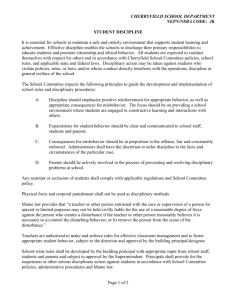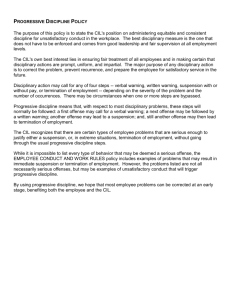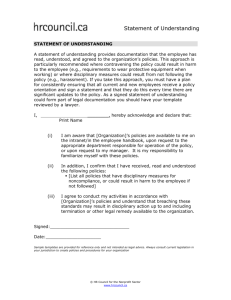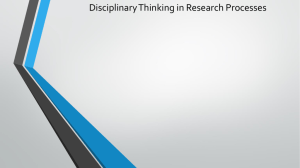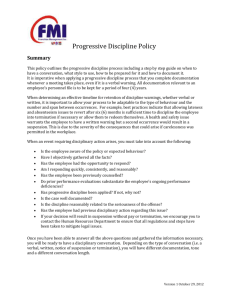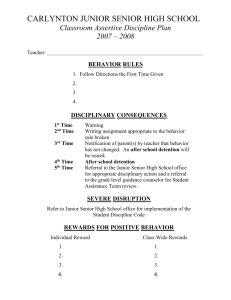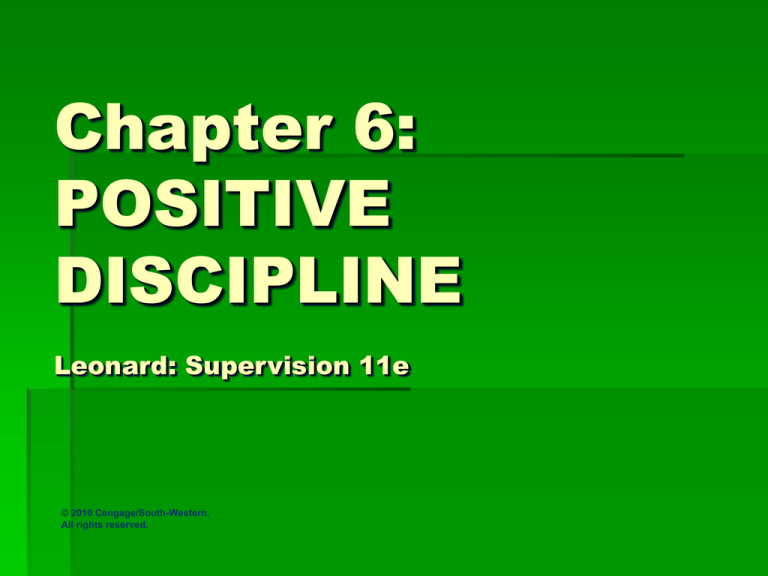
Chapter 6:
POSITIVE
DISCIPLINE
Leonard: Supervision 11e
© 2010 Cengage/South-Western.
All rights reserved.
AFTER STUDYING THIS CHAPTER,
YOU WILL BE ABLE TO:
1. Discuss the basis and importance of positive discipline
in an organization.
2. Identify disciplinary situations that violate standards of
conduct and discuss the need to confront those
situations appropriately.
3. Discuss the disciplinary process and approaches that
ensure disciplinary action for just (proper) cause.
4. Define and discuss the application of progressive
discipline.
5. Explain the “hot stove rule” approach to discipline.
6–2
AFTER STUDYING THIS CHAPTER,
YOU WILL BE ABLE TO: (cont’d)
6. Discuss the need to document disciplinary actions and
to provide the right of appeal.
7. Explain the “discipline without punishment” approach
as an alternative to progressive discipline.
8. Describe the importance of “fairness” in the
disciplinary process.
6–3
The Basis and Importance
of Positive Discipline
• Discipline
State of orderliness; the degree to which employees
act according to expected standards of behavior.
• Positive Discipline
Condition that exists when employees generally
follow the organization’s rules and meet the
organization’s standards.
• Morale
A composite of feelings and attitudes that individuals
and groups of workers have toward their work
environment.
6–4
The Basis and Importance of
Positive Discipline (cont’d)
• Morale
A composite of feelings and attitudes that individuals
and groups of workers have toward their work
environment.
• Positive Self-discipline
Employees regulating their behavior out of self-
interest and their normal desire to meet reasonable
standards.
6–5
Identifying and Confronting
Disciplinary Situations
• Ethical Codes and Policies
Statements of ethical standards or ethical codes
Outline in broad, value-oriented terms the norms and ideals
that are supposed to guide everyone in the organization.
Do not ensure ethical conduct.
• Fostering Ethical Behavior
Develop ethical codes and policies with major input
from teams of employees and supervisors
Established hotlines or an ethics-reporting system
Appoint a “corporate ombudsman”
Protect “whistle-blowers”
6–6
Identifying and Confronting
Disciplinary Situations (cont’d)
• Conflict-of-Interest Statements
Define situations and employee behaviors that are
inconsistent with an individual’s primary obligations to
the employer.
• Ethical Commitment
Requires everyone in the organization, especially
those in management and supervision, to show daily,
by word and deed, that behaving ethically at work is
not optional.
6–7
Identifying and Confronting
Disciplinary Situations (cont’d)
• Rules of Conduct:
Inform employees which standards of behavior are
expected and which behaviors are unacceptable.
Are sometimes included in employee handbooks;
sometimes they are provided as separate booklets or
as memoranda posted in departments.
Should help the supervisor encourage positive
employee self-discipline.
Are often subject to review and change because of
legal problems and interpretations.
6–8
Identifying and Confronting
Disciplinary Situations (cont’d)
• Confronting Disciplinary Situations
Situations requiring supervisory disciplinary actions:
Infractions of rules regarding time schedules, rest periods,
procedures, safety, and so forth
Excessive absenteeism or tardiness
Defective or inadequate work performance
Poor attitudes that influence the work of others or damage the
firm’s public image
Supervisors must be prompt, firm and impartial in
their responses to disciplinary problems.
6–9
The Disciplinary Process and Just Cause
• Disciplinary Action Should Have Just Cause
Just Cause
Sets the standard for disciplinary action requiring tests of
fairness and elements of normal due process, investigation,
sufficient evidence, and a penalty commensurate with the
nature of the infraction.
6–10
The Disciplinary Process
• Precautionary Questions and Measures
Investigate the situation
Are all or most of the facts available, and are they reported
accurately?
How serious is the offense (minor, major, or intolerable)?
Did the employee know the rule or standard?
What is the employee’s disciplinary record, length of service,
and performance level?
Should the employee receive the same treatment others have
had for the same offense?
6–11
The Disciplinary Process (cont’d)
• Precautionary Questions and Measures (cont’d)
Investigatory interviews
Conduct confidential interviews in private and in a nonthreatening manner.
Allow the employee to have a witness present during the
interview
Ask both directive and nondirective questions that are
designed to elicit specific answers about what happened and
why.
Avoid making final judgments until all interviews have been
conducted and other relevant information assembled.
6–12
The Disciplinary Process (cont’d)
• During the disciplinary process, supervisors
should:
Maintain self-control at all times during the process.
Should conduct the disciplinary process in a way that
respects the disciplined employee’s privacy.
• Disciplinary Time Element
Minor disciplinary offenses are not counted against
the employee after a period of time.
Serious offenses may require immediate disciplinary
action.
6–13
Practicing Progressive Discipline
• Progressive Discipline
A system of disciplinary action that increases the
severity of the penalty with each offense.
• Stages in Progressive Discipline
Informal discussion with the employee
Oral warning including counseling
Written warning
Disciplinary layoff (suspension)
Transfer or demotion
Discharge
6–14
Practicing Progressive Discipline (cont’d)
• Early Stages in Progressive Discipline
Informal discussion
Determine reasons for employee conduct
Reaffirm employee’s responsibility for behavior
Record date, place, and time of discussion
Oral warning (verbal counseling)
Impress on employee the necessity for changing behavior
Warn employee of the consequences of continuing behavior
Notate warning in employee’s record
Issue letter of clarification to employee
6–15
Practicing Progressive Discipline (cont’d)
• Early Stages in Progressive Discipline (cont’d)
Written warning
A formal document that becomes part of the employee’s
permanent record
Reemphasize the necessity for the changing behavior to
avoid more serious disciplinary action
Have employee sign written warning or note refusal to sign
6–16
Practicing Progressive Discipline (cont’d)
• Advanced Stages in Progressive Discipline
Disciplinary Layoffs (Suspensions):
Involve a loss of pay and usually extend from one day to
several days or weeks.
Typically must be approved by higher-level managers after
consulting with the human resources department.
Transfer:
Is taken when an employee is experiencing difficulty with a
supervisor, a job, or associating with certain employees.
Demotion:
Is downgrading an employee to a lower-paying job.
Should be used only in unusual situations in which
disciplinary layoff or discharge is not a better alternative.
6–17
Practicing Progressive Discipline (cont’d)
• Advanced Stages…(cont’d)
Discharge:
Is the most drastic form of disciplinary action taken only for
the most serious offenses and as a last resort.
Involves loss and waste—training a replacement and
disrupting the makeup and morale of the work group.
Can result in grievance and arbitration proceedings.
May involve meeting standards for nondiscrimination.
Is a decision reserved for higher-level managers with
approval by the human resources department.
6–18
Practicing Progressive Discipline (cont’d)
• Advanced Stages…(cont’d)
Employment-at-will:
Is a legal concept that employers can dismiss employees at
any time and for any reasons, except unlawful discrimination
and contractual or other restrictions.
Allows employees to also terminate their employment
relationship at any time for any reasons.
Is subject to state and federal court exceptions that restrict its
application.
Does not mean that a discharge action should not have a
rational basis, be for just or good cause, or have an economic
basis (e.g., layoff for no available work)
6–19
FIGURE 6.10
Sample employment-at-will policy from a bank.
EMPLOYMENT-AT-WILL POLICY
Citizens Bank is an at-will employer. This means that employees may
resign from the bank if they choose to do so. Similarly, the bank may
discharge an employee at any time, for any reason, with or without
notice. Nothing in this handbook or any other manual or policy
adopted by Mercantile in any way alters the at-will nature of Citizens
Bank employment. The separation decision is not to be made without
serious consideration by either the employer or employee. Generally,
an employee choosing to leave will give appropriate notice, and
discharges are not likely to occur precipitously.
6–20
Applying the Hot Stove Rule
• Hot Stove Rule
A guideline for applying discipline analogous to
touching a hot stove in that it:
Gives advance warning (it is red-hot)
Has immediate consequences (it burns when touched)
Is consistently applied (it burns every time)
Is applied with impersonality (it burns all who touch it)
6–21
Applying the Hot Stove Rule (cont’d)
• Advance Warning
Employees must know in advance their expectations
as well as rules and regulations.
Employees must be informed clearly that certain acts
will lead to disciplinary action.
Employees should be required to sign documents
stating that they have (a) received, (b) read, and (c)
understood the company handbook and that they are
willing to comply with the rules and regulations
contained therein.
Previously unenforced rules can be reinstated once
prior notice and warnings are given.
6–22
Applying the Hot Stove Rule (cont’d)
• Immediacy
Disciplinary action should be taken as promptly as
possible after the offense.
Immediate discipline (temporary suspension) is
required for a serious offense and to provide time to
investigate the offense and to determine whether or
not further disciplinary action is warranted.
6–23
Applying the Hot Stove Rule (cont’d)
• Consistency
Appropriate disciplinary action should be taken each
time an infraction occurs.
Inconsistent discipline leads to employee anxiety and
creates doubts as to what employees can and cannot
do.
Consistency does not necessarily mean treating
everyone in the same manner in all situations—
employees must feel that any other employee in the
same situation would receive similar treatment.
6–24
Applying the Hot Stove Rule (cont’d)
• Impersonality
All employees who commit the same or a similar
offense should be treated the same way.
Penalties should be connected with the offense, not
with the offending employee.
Making a disciplinary action impersonal reduces the
level of resentment felt by the employee.
6–25
Applying the Hot Stove Rule (cont’d)
• No-Fault Attendance Policy
Is a policy under which unscheduled absences and
tardiness are counted as occurrences and their
accumulation is used in progressive discipline.
Is often preferred by supervisors because they do not
have to assess or determine the legitimacy of an
employee’s unscheduled absence.
6–26
Documentation and the Right To Appeal
• Documentation
Records of memoranda, documents, and meetings
that relate to a disciplinary action.
• Right to Appeal
Procedures by which an employee may request
higher-level management to review a supervisor’s
disciplinary action.
6–27
Discipline without Punishment
• Discipline without Punishment
Uses coaching and counseling as preliminary steps
and a paid “decision-making leave” that allows
employees to decide whether to stay and improve or
to quit.
The optimal reaction to discipline is acceptance of
responsibility for the wrongdoing and a change in
behavior by the employee to the desired standards
with no severe side effects.
If an employee commits to improving but fails to do
so, the employee is terminated.
6–28
It’s Not Fair
• Norms
Standards shared by most employees for how one
should act and be treated in the organization
• Fair Treatment
Impartial and appropriate actions taken that are free
of favoritism and bias
Contingent upon:
the interactions one has with their supervisor
the procedures used to arrive at the action taken
and outcomes
6–29
It’s Not Fair (cont’d)
• People react to unfair treatment in 3 ways:
Fight
Flight
Go with the Flow
6–30
KEY TERMS
• Discipline
• Discipline without punishment
• Documentation
• Employment-at-will
• Fair treatment
• Hot stove rule
• Morale
• No-fault attendance policy
• Norms
• Positive discipline
• Positive self-discipline
• Progressive discipline
• Right to appeal
6–31


